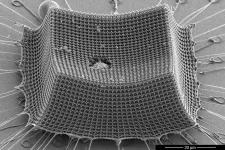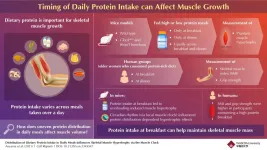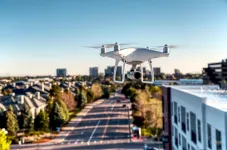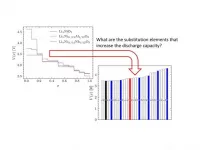(Press-News.org) RESEARCH TRIANGLE PARK, N.C. -- Army-funded research identified a new material that may lead to lightweight armor, protective coatings, blast shields and other impact-resistant structures.
Researchers at the U.S. Army's Institute for Soldier Nanotechnologies at the Massachusetts Institute of Technology, Caltech and ETH Zürich found that materials formed from precisely patterned nanoscale trusses are tougher than Kevlar and steel.
In experiments, the ultralight structures, called nanoarchitectured materials, absorbed the impact of microscopic projectiles accelerated to supersonic speeds.
"Increasing protection while simultaneously decreasing the weight that soldiers carry is an overreaching theme in our research," said Dr. James Burgess, ISN program manager for the U.S. Army Combat Capabilities Development Command, known as DEVCOM, Army Research Laboratory. "This project is a really good example of such efforts where projectile energy absorption is nanostructured mechanism based."
The research, published in Nature Materials, found that the material prevented the projectiles from tearing through it.
"The same amount of mass of our material would be much more efficient at stopping a projectile than the same amount of mass of Kevlar," said Dr. Carlos Portela, assistant professor of mechanical engineering at MIT, the study's lead author.
The researchers calculate that the new material absorbs impacts more efficiently than steel, Kevlar, aluminum and other impact-resistant materials of comparable weight.
"The knowledge from this work...could provide design principles for ultra-lightweight impact resistant materials [for use in] efficient armor materials, protective coatings, and blast-resistant shields desirable in defense and space applications," said co-author Dr. Julia R. Greer, a professor of materials science, mechanics, and medical engineering at Caltech, whose lab fabricated the material.
Nanoarchitected materials are known to feature impressive properties like exceptional lightness and resilience; however, until now, the potential for additional applications has largely been untested.
"We only know about its response in a slow-deformation regime, whereas a lot of their practical use is hypothesized to be in real-world applications where nothing deforms slowly," Portela said.
To help fill this vital knowledge gap, the research team set out to study nanoarchitected materials undergoing fast deformation, such as that caused by high-velocity impacts. At Caltech, researchers first fabricated a repeating pattern known as a tetrakaidecahedron--a lattice configuration composed of microscopic struts--using two-photo lithography, a technique that uses a high-powered laser to solidify microscopic structures in photosensitive resin.
To test the tetrakaidecahedron's resilience to extreme, rapid deformation, the team performed experiments at MIT using the ISN-developed laser-induced particle impact array. This device aims an ultrafast laser through a glass slide.. As the laser passes through the slide, it generates a plasma, an immediate expansion of gas that launches the particles toward the target.
By adjusting the laser's power to control the speed of the microparticle projectiles, the researchers tested microparticle velocities within the supersonic range.
"Some experiments achieved twice the speed of sound, easily," Portela said.
Using a high-speed camera, the researchers captured videos of the microparticles impacting the nanoarchitected material. They had fabricated material of two different densities. A comparison of the two materials' impact response, found the denser one to be more resilient, and microparticles tended to embed in the material rather than tear through it.
To get a closer look, the researchers carefully sliced through the embedded microparticles and nanarchitectured target. They found that the struts below the embedded particle had crumpled and compacted in response to the impact, but the surrounding struts remained intact.
"We show the material can absorb a lot of energy because of this shock compaction mechanism of struts at the nanoscale, versus something that's fully dense and monolithic, not nanoarchitected," Portela said.
Going forward, Portela plans to explore various nanostructured configurations other than carbon, and ways to scale up the production of these nanostructures, all with the goal of designing tougher, lighter materials.
"Nanoarchitected materials truly are promising as impact-mitigating materials," Portela said. "There's a lot we don't know about them yet, and we're starting this path to answering these questions and opening the door to their widespread applications."
INFORMATION:
The U.S. Army established the MIT Institute for Nanotechnologies in 2002 as an interdisciplinary research center to dramatically improve the protection, survivability and mission capabilities of the Soldier and of Soldier-supporting platforms and systems.
In addition to Army funding through the institute, the U.S. Office of Naval Research and the Vannevar Bush Faculty Fellowship supported the research.
Visit the laboratory's Media Center to discover more Army science and technology stories
As the Army's national research laboratory, ARL is operationalizing science to achieve transformational overmatch. Through collaboration across the command's core technical competencies, DEVCOM leads in the discovery, development and delivery of the technology-based capabilities required to make Soldiers more successful at winning the nation's wars and come home safely. DEVCOM Army Research Laboratory is an element of the U.S. Army Combat Capabilities Development Command. DEVCOM is a major subordinate command of the Army Futures Command.
It's no secret that studies show that sexually diverse youth - in particular, lesbian, gay and bisexual (LGB) youth - use more cannabis and experience more mental health challenges than their heterosexual peers.
But what about the changes that occur in the rates of cannabis use: do they precede those related to mental health or is it the other way around? A new study from Université de Montréal offers some answers.
In the Journal of Abnormal Psychology, Kira London-Nadeau, a doctoral student and CIHR Vanier Scholar in the Department of Psychology at UdeM and the CHU Sainte-Justine Research ...
Germany is not meeting its legal obligations to protect refugee women and girls from discrimination. This is the conclusion of a "shadow report" by the University of Göttingen, the association Pro Asyl and the refugee councils of Bavaria, Hesse, Lower Saxony and Saxony-Anhalt. Shadow reports are a useful tool to present important information in parallel with official government reports. Based on current research results and a survey of 65 women's counselling centres, psychosocial counselling centres and institutions working with refugees from all 16 federal states, the study finds that Germany does not adequately protect refugee women and girls and does not meet the requirements of the Istanbul Convention.
"The Istanbul Convention - also known as the Council of Europe convention ...
A coronavirus related to the virus that causes Covid-19 in humans has been found in UK horseshoe bats - according to new collaborative research from the University of East Anglia, ZSL (Zoological Society of London), and Public Health England (PHE).
However, there is no evidence that this novel virus has been transmitted to humans, or that it could in future, unless it mutates.
UEA researchers collected faecal samples from more than 50 lesser horseshoe bats in Somerset, Gloucestershire and Wales and sent them for viral analysis at Public Health England.
Genome sequencing found a novel coronavirus in one of the bat samples, which the team have named 'RhGB01'.
It is the first time that a sarbecovirus ...
UK policymakers preparing trade deals post-Brexit can learn important lessons from New Zealand's 'unique drug agency' the Pharmaceutical Management Agency (PHARMAC), if prices for therapies and access to key drugs are to be protected, say researchers behind a new study.
Over two decades, New Zealand has managed to reduce spending on drugs significantly and consistently despite maintaining access for its population to key treatments. As such, it is an outlier among the world's richest nations: no other OECD country has managed to achieve this.
The investigation from researchers at the universities of Bath and Durham suggest New Zealand's ...
Research led by the University of Southampton into the uptake of the COVID-19 vaccine in Ghana, West Africa has concluded that vaccine hesitancy has seen a small, but significant increase over the last three months. This research is in collaboration with youth-led not-for-profit organisation PACKS Africa.
In the latest survey of 1,295 unvaccinated people, in May/June 2021, willingness to be vaccinated remained relatively high at just over 71.4 percent. However, this figure is down 11 percent on results from March 2021 when an earlier version of the same survey was conducted.
The latest findings show 28.6 percent of respondents are still either undecided or unwilling to get the jab. Among this 28.6 percent group, a little over half said ...
Proteins constitute an essential dietary component that help in the growth and repair of the body. Composed of long chains of amino acids, proteins promote the growth of skeletal muscles, the group of muscles that help us move. Humans have been aware of the benefits of proteins for long. However, recent studies have shown that having the right amount of protein at the right time of the day is essential for proper growth. This is called 'Chrononutrition,' in which when you eat is as important as what and how you eat.
The reason behind this is the body's internal biological clock, called the 'circadian rhythm.' This rhythm is followed by all cells and controls life functions like metabolism and growth. Interestingly, protein digestion and absorption have been ...
Chemical synapses transmit information within the nervous system. When a presynaptic cell is electrically excited, synaptic vesicles fuse with the presynaptic membrane causing messenger substances within the vesicles to be released into the synaptic cleft. These then bind to receptors in the postsynaptic cell where they trigger an electrical signal once again. The temporal and spatial sequence of the incoming signals determines how information is processed and transmitted in the brain. In order to sustain their function in the long term, chemical synapses need to recycle synaptic vesicles to make them available for renewed signal transmission. Professor Carsten Duch and Professor Martin Heine and their respective ...
"The project's main objective is to integrate a certain degree of automation, so that an operator can control a small fleet of up to 10 drones from a single ground station," says Luis E. Moreno, LABYRINTH's coordinator and researcher at the UC3M's Robotics Lab. "The idea is that the operator indicates the mission to be undertaken (for example, monitoring traffic in a particular area) and the system automatically converts this mission into a set of routes that each drone has to follow, automatically calculating alternative routes when necessary," he explains. In addition ...
The economic and environmental pros and cons of melting Arctic ice creating shorter shipping routes through the polar region are weighed up in ground-breaking research from UCL experts in energy and transport.
They conclude that policy makers must properly assess the environmental trade-offs and costs in addition to the commercial benefits and opportunities in Arctic shipping. The authors also want to see more incentives to drive technological developments that will accelerate the uptake of green fuels and technologies.
The Arctic is the fastest-warming region on the planet.
Shorter Arctic shipping routes, which mean less fuel used are already used by a handful of ships, when areas of the Arctic ice melt ...
Ishikawa, Japan - Powering everything from smartphones to electric cars, lithium-ion batteries (LIBs) have evolved markedly with advances in technology and revolutionized our world. The next step in the progress of technology is developing even better batteries to power electronic devices for longer durations. One promising technique for increasing battery performance involves the atomic substitution of positively charged ions or "cations" in the cathode material. However, doing so systematically for different substituent cations to determine the ideal ones experimentally is complex and expensive, leaving us with simulations as the only viable option for narrowing down the choices.
Several studies have reported an improved battery life and ...




